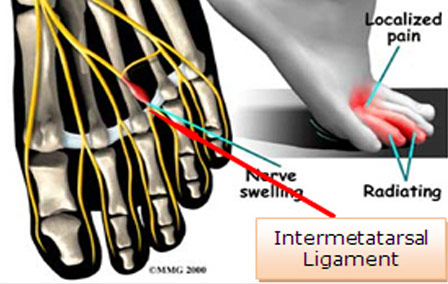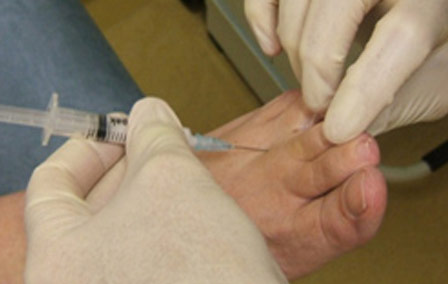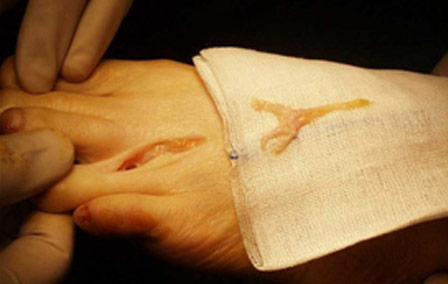Mortons Neuroma
Interdigital Neuroma (Perineural Fibrosis)

Interdigital neuroma (Morton’s Neuroma) of the foot includes common, paroxysmal, neuralgia affecting the web spaces of the toes. It involves entrapment neuropathy (nerve compression) of the common digital nerve below and between the metatarsal heads, typically between the third and the fourth metatarsal heads. The pain is most commonly felt between the third and fourth toes but can also occur in the area between the second and third toes.
Symptoms of interdigital neuroma typically manifest as a sharp, burning or tingling sensation in the forefoot. The pain radiates toward the lesser toes and is aggravated by shoe wear. The pain is relieved when the shoe is removed and the forefoot is massaged. Sometimes the symptoms involve specific toes. The cause of this problem is often due to impingement of the plantar nerve fibres between the metatarsal heads and the intermetatarsal ligament. It is entirely a biomechanical phenomenon. Differential diagnoses include stress fracture, capsulitis, bursitis or ligament injury at the metatarsal-phalangeal joint, a tendon sheath ganglion, foreign-body reaction and nerve-sheath tumour.
Diagnostic Procedures For Interdigital Neuroma

The diagnosis of interdigital neuroma is usually made by physical examination and review of the patient’s medical history.MRI ad High Definition Ultrasound examination may be useful to confirm the diagnoses however they may still not be 100% reliable.
The commonest reason for this is
Treatment

Conservative treatment involves a reduction in the inflammation and removing the impingement factor. Reduction in inflammation is achieved via rest, elevation, ice, and massage with anti-inflammatory gels. Removing footwear
Surgery

Majority of publications including peer review journal articles, surgical technique description and textbooks promote surgical excision as a gold standard treatment. Surgical excision is described as the most definitive mode of treatment for symptomatic Morton’s neuroma with reported success rates varying between 79% and 93%.
Various surgical techniques are described, essentially categorised as dorsal versus plantar incision approaches. Beyond
What Is Involved In Neuroma Surgery?
Surgery to excise the neuroma is usually performed under general anaesthetic in a day surgery facility. After surgery, you will have to keep your foot dry for two weeks. Generally, neuroma surgery allows for early weight bearing and protection in some type of
Interdigital neurectomy (removal of the diseased nerve) in right hands, should give satisfactory results almost all the time. Some of the reasons behind the failure
It is crucial to address the biomechanical pathologies underlying the impingement of the nerve during and after the surgery. Ozan will work closely with your Podiatrist in providing appropriate orthotic therapy to address these biomechanical issues.
